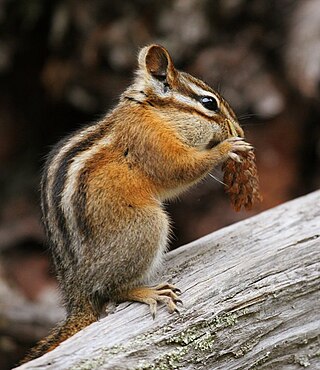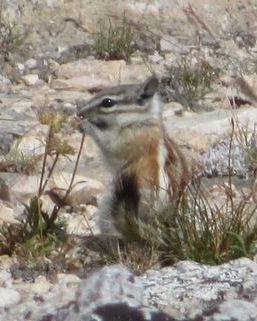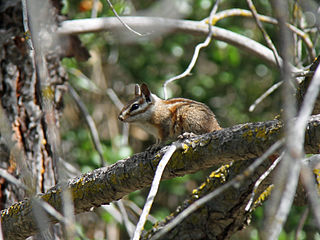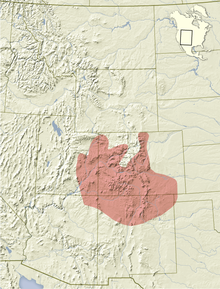
Chipmunks are small, striped rodents of Sciuridae, the squirrel family; specifically, they are ground squirrels (Marmotini). Chipmunks are found in North America, with the exception of the Siberian chipmunk which is found primarily in Asia.

Ground squirrels are rodents of the squirrel family (Sciuridae) that generally live on the ground or in burrows, rather than in trees like the tree squirrels. The term is most often used for the medium-sized ground squirrels, as the larger ones are more commonly known as marmots or prairie dogs, while the smaller and less bushy-tailed ground squirrels tend to be known as chipmunks.

The least chipmunk is the smallest species of chipmunk and the most widespread in North America.

The yellow-bellied marmot, also known as the rock chuck, is a large, stout-bodied ground squirrel in the marmot genus. It is one of fourteen species of marmots, and is native to mountainous and semi-arid regions of southwestern Canada and western United States, including the Rocky Mountains, Sierra Nevada, and the Great Basin, often living above 2,000 metres. The fur is mainly brown, with a dark bushy tail, yellow chest and white patch between the eyes, and they weigh up to approximately 5 kilograms. They live in burrows in colonies of up to twenty individuals with a single dominant male. They are diurnal and feed on plant material, insects, and bird eggs. They hibernate for approximately eight months starting in September and lasting through the winter.

The Hopi chipmunk, Neotamias rufus, is a small chipmunk found in Colorado, Utah and Arizona in the southwestern United States. It was previously grouped with the Colorado chipmunk, T. quadrivittatus. This species is listed as "Least Concern" on the IUCN Red List as it is common, widespread, and without any major threats. It was last evaluated in 2016.

The alpine chipmunk is a species of chipmunk native to the high elevations of the Sierra Nevada of California.

The Columbian ground squirrel is a species of rodent common in certain regions of Canada and the northwestern United States. It is the second largest member of the genus Urocitellus, which is part of the tribe Marmotini, along with marmots, chipmunks, prairie dogs, and other holarctic ground squirrels. They are stout, with short dense fur, which is characteristically tawny across the bridge of the nose. Social encounters sometimes are initiated with kissing behavior and the most common activity above ground is standing at attention. Residing in mountainous terrain and high plains in northern latitudes, they hibernate for 8 to 9 months of the year in burrows, which may be used for many years. They are emaciated when emerging in the spring. The Columbian ground squirrel came to the attention of the scientific community through writings produced by Lewis and Clark, while 21st century molecular genetics has more finely illuminated its ties with other close relatives.

The yellow-pine chipmunk is a species of order Rodentia in the family Sciuridae. It is found in parts of Canada and the United States.

The gray-footed chipmunk is a terrestrial and forest-dwelling species of chipmunk and rodent in the family Sciuridae. It is endemic to New Mexico and in the Sierra Diablo and Guadalupe Mountains in the Trans-Pecos region of Texas in the United States. Its natural habitat are coniferous forests. First discovered in 1902, they are distinguished by the unique gray dorsal colouring on the hind feet, hence the common name. They demonstrate sexual dimorphism, and the female is larger than the male.

The gray-collared chipmunk is a species of rodent in the family Sciuridae. It is endemic to Arizona and New Mexico in the United States.

Merriam's chipmunk is a species of rodent in the family Sciuridae. It is found in central and southern California in the United States and a small area in northern Baja California, Mexico.

The yellow-cheeked chipmunk, also known as the redwood chipmunk, is a species of rodent in the squirrel family, Sciuridae. It is endemic to areas near the coast of northern California in the United States where it inhabits coastal coniferous forest.

The red-tailed chipmunk is a species of rodent in the family Sciuridae. It is found in Alberta and British Columbia in Canada and Montana, Idaho and Washington in the United States.

Allen's chipmunk, also known as the shadow chipmunk, is a species of chipmunk native to the western United States. Occurring in California, Oregon, and Nevada, it is a common species of the Sierra Nevada.

The Sonoma chipmunk is a species of rodent in the squirrel family Sciuridae. It is endemic to northwestern California in the United States. Members of Neotamias are characterized by having two premolars. N. sonomae has two subspecies: N. s. alleni and N. s. sonomae.

The Lodgepole chipmunk is a species of rodent in the family Sciuridae. It is found in the U.S. state of California at elevations from 1,500 to 3,000 metres. The Lodgepole chipmunk has a variety of common names including: Tahoe chipmunk, Sequoia chipmunk, Mt. Pinos chipmunk, and San Bernardino chipmunk.

The Uinta chipmunk or hidden forest chipmunk, is a species of chipmunk in the family Sciuridae. It is endemic to the United States. Formerly known as Tamias umbrinus, phylogenetic studies have shown it to be sufficiently distinct from the eastern chipmunk as to be placed in a separate genus, Neotamias. The same studies have also suggested that Palmer's chipmunk may actually be a subspecies of Uinta chipmunk, although the two are still generally regarded as separate species.

Neotamias is a genus of chipmunks within the tribe Marmotini of the squirrel family. It contains 23 species, which mostly occur in western North America. Along with Eutamias, this genus is often considered a subgenus of Tamias.

The Ezo chipmunk is a subspecies or local population of the Siberian chipmunk; it is found in what was once known as Ezo, namely Hokkaidō, Japan, and Sakhalin and the Southern Kuriles, Russia.





















